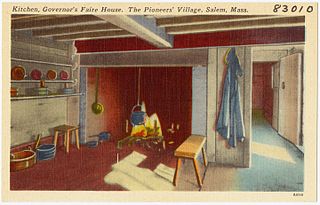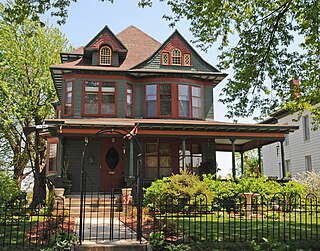
The Danvers State Hospital, also known as the State Lunatic Hospital at Danvers, The Danvers Lunatic Asylum, and The Danvers State Insane Asylum, was a psychiatric hospital located in Danvers, Massachusetts. It was built in 1874, and opened in 1878, under the supervision of prominent Boston architect Nathaniel Jeremiah Bradlee, on an isolated site in rural Massachusetts. It was a multi-acre, self-contained psychiatric hospital designed and built according to the Kirkbride Plan.

The Nathaniel Bowditch House, sometimes called the Bowditch-Osgood House and the Curwen-Ward-Bowditch House, is a historic house and National Historic Landmark at 9 North Street in Salem, Massachusetts. With a construction history apparently dating to 1759–60, the house is distinctive as having been owned by three families important in the maritime history of Salem. Its landmark designation in 1965 stems from its association with Nathaniel Bowditch (1773–1838), the founder of modern navigation, who lived here from 1811 to 1823. The house now serves as the headquarters of Historic Salem, Inc., which was responsible for its rescue from demolition and eventual restoration.
This is a list of properties and historic districts listed on the National Register of Historic Places in Norfolk County, Massachusetts, other than those within the city of Quincy and the towns of Brookline and Milton. Norfolk County contains more than 300 listings, of which the more than 100 not in the above three communities are listed below. Some listings extend across municipal boundaries, and appear on more than one list.

Pioneer Village, also known as Salem 1630: Pioneer Village, is a living history museum recreating the city of Salem as it was in the 17th century. Opened in June 1930, it was the first museum of its kind in the United States.

The U.S. National Register of Historic Places (NRHP) classifies its listings by various types of properties. Listed properties generally fall into one of five categories, though there are special considerations for other types of properties which do not fit into these five broad categories or fit into more specialized subcategories. The five general categories for NRHP properties are: building, district, object, site, and structure.

The First Universalist Society of Salem is a historic Universalist former church building at 211 Bridge Street in Salem, Massachusetts.

Downtown Salem District is a historic district roughly bounded by Church, Central, New Derby, and Washington Streets in Salem, Massachusetts. It was added to the National Register of Historic Places in 1983, and represents a major expansion of the Old Town Hall Historic District, which was listed in 1972.

The Essex Institute Historic District is a historic district at 134-132, 128, 126 Essex Street and 13 Washington Square West in Salem, Massachusetts. It consists of a compact group of properties associated with the Essex Institute, founded in 1848 and merged in 1992 into the Peabody Essex Museum. Listed by increasing street number, they are: the Crowninshield-Bentley House, the Gardner-Pingree House, the John Tucker Daland House, and the Phillips Library. The John Ward House, which fronts on Brown Street but shares the 132 Essex Street address, is another National Historic Landmark within the district. The Andrew Safford House at 13 Washington Square West, built in 1819, was said to be the most expensive home in New England at the time.

Beebe Homestead, also known as the Lucius Beebe House and Beebe Farm, is a historic Federal period home at 142 Main Street in Wakefield, Massachusetts, which was built during the federal era that extended from the late 18th-century into the 1820s. It is suspected to have been remodeled into the federal style from an earlier home built in circa 1727. It overlooks Lake Quannapowitt, and according to a 1989 study of historic sites in Wakefield, the house is "one of Wakefield's most imposing landmarks." The property was added to the National Register of Historic Places in 1989.

The Mill Street–North Clover Street Historic District is located along those streets and Main Street in western Poughkeepsie, New York, United States. It is an irregularly-shaped area of 27 acres (11 ha) between US 9 and downtown Poughkeepsie, located on the slope up from the Hudson River. There are roughly 139 historic buildings, and very few new ones.

The Worcester City Hall and Common, the civic heart of the city, are a historic city hall and town common at 455 Main Street in Worcester, Massachusetts. The city hall and common were added to the National Register of Historic Places in 1978.

The Downtown Albany Historic District is a 19-block, 66.6-acre (27.0 ha) area of Albany, New York, United States, centered on the junction of State and North and South Pearl streets. It is the oldest settled area of the city, originally planned and settled in the 17th century, and the nucleus of its later development and expansion. In 1980 it was designated a historic district by the city and then listed on the National Register of Historic Places.

The Rose Hill Historic District is a nationally recognized historic district located in Sioux City, Iowa, United States. It was listed on the National Register of Historic Places in 2002. At the time of its nomination it contained 217 resources, which included 132 contributing buildings 84 non-contributing buildings, and one non-contributing site. The district is located within the larger Rose Hill Addition, which was laid out by a group of Sioux City entrepreneurs in 1884. It includes many mansions built for the wealthy from about 1890 to 1910, most of which were later divided into apartments. The Elzy G. Burkam House (1894) and adjacent garage are contributing properties. It also included a 125-year-old house at 1529 Grandview Boulevard which was demolished in 2015 after a long controversy about historic preservation.

This is a list of the National Register of Historic Places listings in Mobile, Alabama.

The Cottage Home Historic District is a historic district and neighborhood located on the near east side of Indianapolis, Indiana. A small portion of Cottage Home is listed on the National Register of Historic Places while a larger area is listed on the state and local levels. Known for its preponderance of "cottage-style" homes built with strong Victorian influences, Cottage Home has historically been a working class neighborhood. Numerous industrial buildings are also scattered throughout the district, providing a base of economic activity. Today, however, many of these buildings are vacant, providing a special challenge to preservation and urban renewal efforts.
This is a timeline of the history of the city of Salem, Massachusetts, United States.

Western Gateway Heritage State Park is a history-focused Massachusetts state park in the city of North Adams managed by the Department of Conservation and Recreation. Exhibits at the park, which is located in a former railyard, tell the story of the creation of the Hoosac Tunnel. The freight yard was listed on the National Register of Historic Places in 1972 as the Freight Yard Historic District.

The Beverly Depot–Odell Park Historic District encompasses a commercial and industrial area of Beverly, Massachusetts that was developed to its height in the late 19th and early 20th centuries. A central theme of the district relates to Beverly's transportation history with several railroad-related buildings, a carriage manufactory and early automobile factory. The district, listed on the National Register of Historic Places in 2014, include two buildings previously listed: the Beverly Depot, built 1896, and the main post office, built 1910.

Antoinette Forrester Downing was an American architectural historian and preservationist who wrote the standard reference work on historical houses in Rhode Island. She is credited with spearheading a movement that saved many of Providence's historic buildings from demolition in the mid 20th century and for her leadership was inducted into the Rhode Island Heritage Hall of Fame in 1978.

The Main Street and Murray Avenue Historic District of Worcester, Massachusetts encompasses a collection of stylistically similar apartment houses in the city's Piedmont neighborhood. It includes four properties, two each on Main Street and Murray Avenue, which form a cluster of apartment houses of a style that once lined both streets for greater length. The district was listed on the National Register of Historic Places in 2022.





















